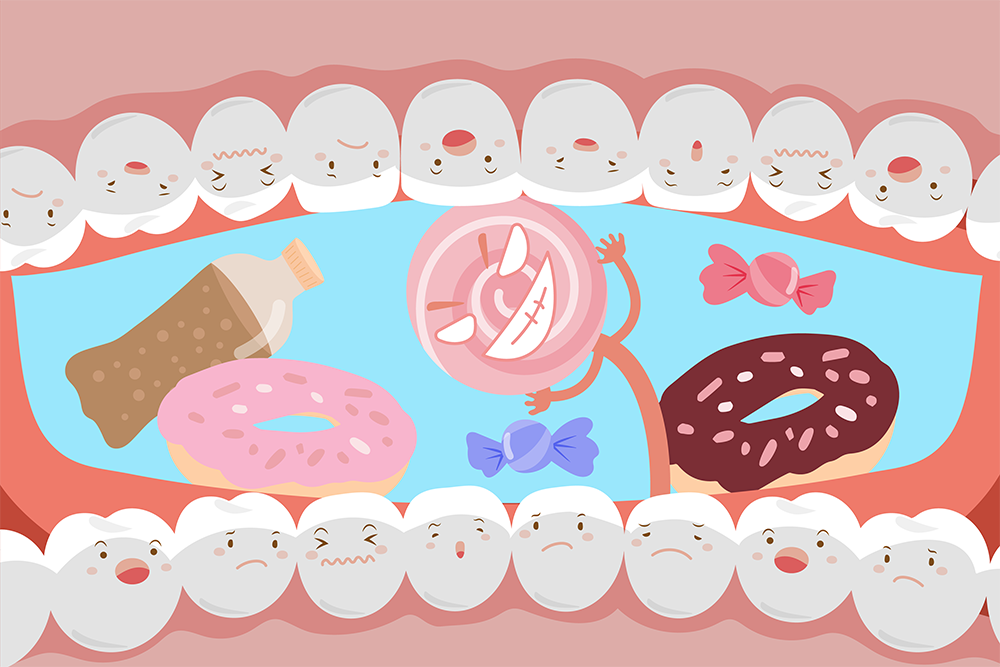Oh No!
My Dentist Says I Have A Cavity.
Why did I get a cavity?
It’s possible to get a cavity even with good at home dental care. Cavities are holes that occur in our teeth. Tooth decay is caused by bacteria that live in plaque, a sticky substance that forms on our teeth on gums. The bacteria feed on sugar in food and drinks, producing acid that can cause damage to the outer layer of our teeth—the enamel. If a cavity is small and shallow, you may not feel any pain or sensitivity. However, left untreated, the hole in your tooth can extend to the nerve, causing an infection in your bone which can spread to other parts of the body.

What treatment options are available for a cavity?
Once tooth decay has gone past the outer layer of the tooth, dental treatment is needed to stop the decay from getting worse. “Treating a cavity in the early stages not only prevents pain but offers the best opportunity for patients to save healthy tooth tissue,” says Dr. Amin Uddin.
A tooth with minimal damage that is not at risk for fracture can be treated by removing the decayed portion of the tooth and filling the hole. Cavities are most often filled with gold, silver amalgam, composite resin, or ceramic. Your dentist will help you weigh the pros and cons of each type of filling based on how big the cavity is, insurance benefits, and aesthetics.
- Composite resin fillings last 5-7 years on average. The color is white and can be matched to teeth. Composite fillings form a strong bond with the tooth, allowing the dentist to remove the least amount of tooth structure and bond the filling material to your natural tooth (compared to an amalgam filling where more natural tooth structure must be removed in order to place the filling).
- Amalgam fillings last at least 10-15 years. They are silver in color and do not match teeth. Possible expansion of amalgam material can lead to fissures or cracks in the tooth. Compared to composite fillings, more natural tooth structure needs to be removed to create space for the amalgam filling. (Some people are concerned about the safety of amalgam fillings because they contain mercury. Studies show no link between amalgam fillings and health problems and the FDA considers amalgam fillings safe for those age six and older.)
When a tooth is at high risk for fracture, a crown may be indicated. Dental crowns are caps placed on top of damaged teeth. They are used to protect, cover, and restore the shape of your tooth when fillings can’t be used. Crowns may be made from metals, porcelain, and resin.
- Ceramic crowns are typically made of a white porcelain material which matches the natural color of your tooth and lasts at least 10-15 years.
- Gold crowns last at least 10-15 years. The color does not match teeth. Of all the materials used for crowns, gold is a product that will best wear to a person’s bite pattern in their mouth due to gold being a softer metal.
When a tooth is at high risk for fracture, a crown may be indicated. Dental crowns are caps placed on top of damaged teeth. They are used to protect, cover, and restore the shape of your tooth when fillings can’t be used. Crowns may be made from metals, porcelain, and resin.
- Ceramic crowns are typically made of a white porcelain material which matches the natural color of your tooth and lasts at least 10-15 years.
- Gold crowns last at least 10-15 years. The color does not match teeth. Of all the materials used for crowns, gold is a product that will best wear to a person’s bite pattern in their mouth due to gold being a softer metal.
A tooth may be extracted, or pulled, if it’s too damaged to benefit from other treatments. An extracted tooth can be replaced with a bridge, dental implant, or denture. Not all teeth need to be replaced, depending on where they are located.
“Treating a cavity in the early stages not only prevents pain but offers the best opportunity for patients to save healthy tooth tissue,” says Dr. Amin Uddin.
Treat Cavities Early
Unfortunately, once tooth decay has gone into the outer layer of a tooth, a dental procedure is needed to stop further damage. Ignoring a cavity will only make treatment more complicated and expensive.
Regular cleanings help prevent tooth decay by removing plaque where bacteria thrive. Regular examinations by your dentist can help detect tooth decay and cavities before extensive treatment is needed. We look forward to seeing you at St. Croix Family Dentistry!
we are part of your community
We proudly Serve the Entire St. croix Valley!
We serve the entire St. Croix Valley, including St. Croix Falls, Taylors Falls, Osceola, Turtle Lake & Grantsburg areas. Our full service dental clinic can still ensure you have the best dental hygiene possible. New patients are always welcome, so come visit us today to discuss your options. You’ll see for yourself why patient satisfaction is so high. Our friendly staff are more than happy to help!
